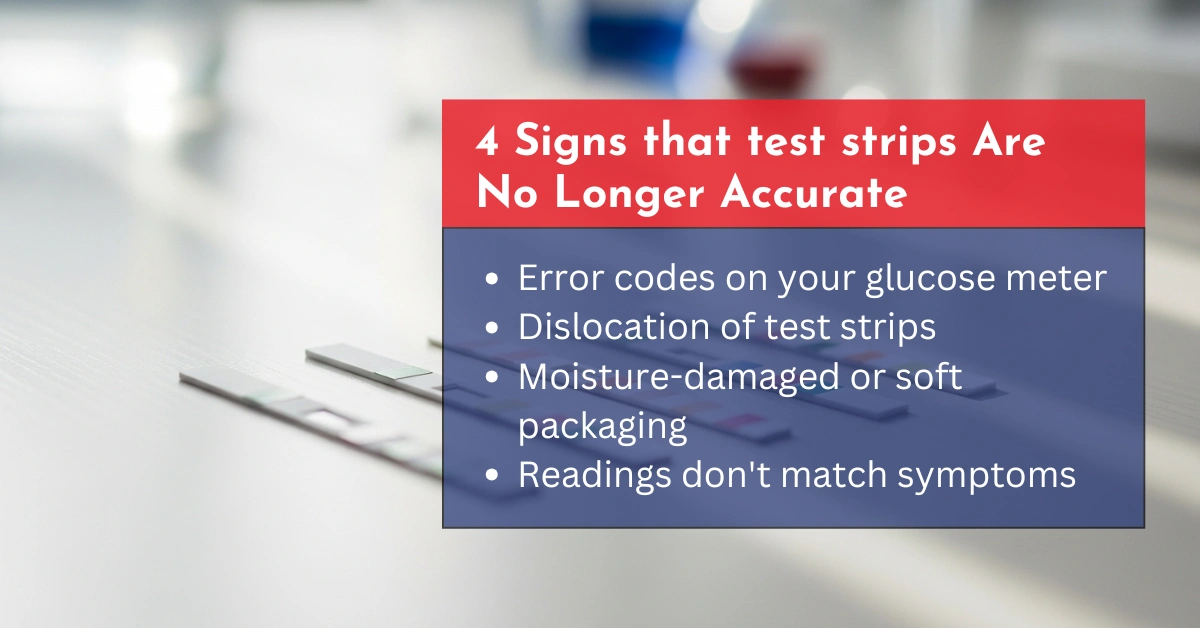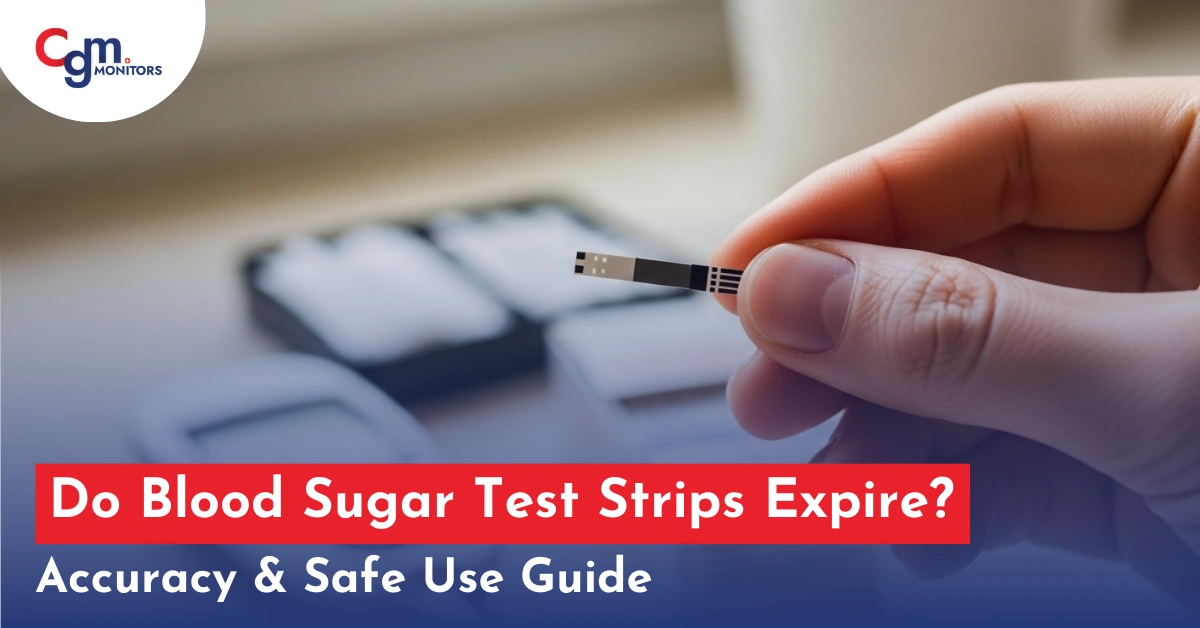Table of content
- What Does “Expire” Mean for Test Strips?
- Shelf Life of Blood Sugar Test Strips
- Risks of Using Expired Test Strips
- Accuracy Problems with Expired Strips
- 4 Signs That Test Strips Are No Longer Accurate
- FDA Guidelines and Warnings
- Proper Storage Practices for Glucose Test Strips
- How Storage Conditions Affect Accuracy
- Patient Education: Best Practices for Glucose Test Strips
- Conclusion
If you’re a diabetic patient, you check your diabetes daily during breakfast, lunch and dinner. One of the most common questions that arises in your mind is: “Do blood sugar test strips expire?”. And this question matters a lot because these strips are not just little pieces of plastic; they are a key to accurate blood glucose monitoring. If you are dealing with type 1 diabetes, type 2 diabetes, and prediabetes, these readings matter a lot. Accurate results from your glucometer guide life-saving decisions about insulin therapy, medication dosing, and diet adjustments.
But concerns often arise when patients notice out-of-date blood glucose test strips at home. Can expired strips still work? Will expired glucose strips read high or low, or should you throw them away immediately?
In this guide, we’ll cover the shelf life of test strips, the science behind their expiration dates, the risks of using expired blood sugar strips, and the best ways to store them for reliable results.
What Does “Expire” Mean for Test Strips?
Manufacturers put a clear expiration date; it’s the period they can guarantee accuracy. After that, there are no safety promises.
- Test strips coated with enzymes like glucose oxidase that react with your blood sample to measure sugar levels.
- Over time, enzymes break down, and the strips won’t react as strongly to your blood glucose.
- Weaker reactions yield wrong results. You could see a false high or a false low, even if your actual blood sugar is stable.
FDA Guidance: Test strips are regulated as Class II medical devices. Manufacturers must validate shelf life before approval.
A 2024 report from Verve Health highlighted that using expired test strips raises the chances of both low blood sugar (hypoglycemia) and high blood sugar (hyperglycemia).
Patients worried about expired strips can consider switching to long-term solutions like the OmniPod 5 G6/G7 Intro Kit or the Guardian Connect System for insulin delivery and glucose monitoring.
Shelf Life of Blood Sugar Test Strips
Many patients wonder, How long do diabetes test strips last if stored properly?
Most glucose test strips last:
- 12-24 months unopened (depending on brand).
- 3-6 months after opening (exposure to air/humidity shortens life).
Shelf Life of Popular Test Strip Brands
| Brand | Shelf Life Unopened | Shelf Life After Opening |
| Accu-Chek | 18-24 months | ~6 months |
| OneTouch Ultra | 18-24 months | ~6 months |
| Contour Next | 24 months | ~6 months |
| FreeStyle Lite | 18 months | ~3-4 months |
Diabetes Diet Life, 2025, highlights that proper storage is essential to maintain strip integrity.
Instead of worrying about expiry dates, you can subscribe to FreeStyle Libre 2 plus Sensor through CGM Monitors and receive fresh sensors on time without risk of stockpiling expired strips.
Risks of Using Expired Test Strips
Many diabetic patients ask: “Can you use expired glucose test strips if they’re still sealed?” The short answer is no. Every box of blood sugar test strips comes with an expiration date. Once that date passes, the results can no longer be trusted. After the expiration date, the enzymes that are coated on the sugar test strip become weak. These different factors affect and weaken faster. Factors like humidity, temperature, and air.
Accuracy and health concerns include:
- False high readings: It may cause unnecessary insulin dosing and leading to hypoglycemia.
- False low readings: It may result in missed insulin doses and put you at risk of hyperglycemia or even diabetic ketoacidosis (DKA).
- A1C fluctuations: Inaccurate daily logs can throw off your long-term diabetes management.
According to the Biological Insights and the American Diabetes Association (ADA) strongly warn the patients to avoid expired strips because they can cause many serious medical issues.
If you want a safe and reliable tracking, you must switch to Continuous Glucose Monitoring (CGM) systems like the Dexcom G6 or FreeStyle Libre 3 plus sensor. Because there is no risk in changing the strips when they have expired
Accuracy Problems with Expired Strips
Expired test strips can read both falsely high and falsely low, depending on the degree of chemical degradation.
- High readings: Enzyme degradation weakens the reaction, which the meter may misread as a higher glucose level.
- Low readings: Moisture contamination can trigger excess reaction, leading the meter to display falsely low glucose levels.
Key Insight: No patient can reliably predict which way expired strips will misread. That unpredictability makes them unsafe.
Because there is no way to predict whether expired strips will overestimate or underestimate blood sugar, using them introduces unnecessary risks in diabetes management. CGM Monitors strongly recommends using only new and the latest Accu Check strips.
4 Signs That Test Strips Are No Longer Accurate
Even before expiration, strips may be damaged. Watch for:
- Error codes on your meter.
- Visible discolouration of strips.
- Soft packaging or moisture exposure.
- Readings inconsistent with physical symptoms.

FDA Guidelines and Warnings
The FDA classifies glucose test strips as Class II medical devices.
Key recommendations:
- Don’t use expired strips for treatment decisions because they may cause serious medical issues.
- Dispose of expired strips safely because they are considered biohazard waste.
- Buy strips only from authorized supplier like CGM Monitors because this helps avoid counterfeit or outdated stock.
- Always check lot numbers and expiration dates because this ensures accuracy and reliability.
The FDA warns that using expired blood sugar test strips can give incorrect results, which may lead to dangerous complications like hypoglycemia or hyperglycemia. Regulatory evidence strongly advises against expired strips to keep diabetes monitoring accurate and safe.
Proper Storage Practices for Glucose Test Strips
To preserve accuracy, strips must be stored correctly:
- You keep your test strip in a sealed original container.
- Store the test strips in a fridge at 36-86°F (2-30°C), away from heat and sunlight.
- Avoid bathrooms, kitchens, or cars because they contain high-humidity zones.
- Do not transfer strips into pillboxes or plastic bags.
Best vs Worst Storage Practices
| Best Practices | Worst Practices |
| Store in original container | Leaving strips loose in a bag |
| Keep the lid tightly closed | Storing in the bathroom or car |
| Store at room temperature (20-25°C) | Exposure to sunlight or heat sources |
| Use a desiccant packet (if provided) | Refrigerating (causes condensation) |
Use a desiccant packet (if provided) Refrigerating (causes condensation)
Tip: Instead of managing multiple supplies, CGM Monitors offers automatic monthly refills for products like Dexcom G7 Sensors and Omnipod Pods, so patients never run out or end up with expired stock.
How Storage Conditions Affect Accuracy
Even before expiry, poor storage damages strips. How long do diabetes test strips last depends heavily on these factors.
| Storage Factor | Impact on Strips | Best Practice |
| Heat (above 86°F) | Enzyme breakdown → false readings | Store at room temperature |
| Humidity | Strips absorb moisture, lose accuracy | Keep the container closed |
| Sunlight | Alters enzyme sensitivity | Store in a dark, cool place |
| Frequent opening | Air exposure reduces shelf life | Open only when needed |
Studies confirm that exposure to these elements can mimic the effects of expiration, causing strips to read high or low unpredictably.
Patient Education: Best Practices for Glucose Test Strips
- Always check the expiration date before use.
- Store strips in their original container.
- Write the opening date on the vial.
- Avoid sharing strips between meters.
- Contact suppliers like CGM Monitors for auto-refill programs to prevent running out.
Additionally, regular meter calibration with control solutions can help detect early inaccuracies, as recommended in diabetes management guidelines.
Conclusion
In summary, do blood sugar test strips expire? Yes. Every box carries an expiration date for a reason. Using the expiry test strip is medically unsafe because it may cause complicated issues. The enzyme breakdown makes the strip give unreliable readings. This isn’t just a small error; it can misguide treatment decisions. For safe diabetes management: Follow FDA guidelines, Store strips correctly, replace them regularly, and consider upgrading to a CGM for accuracy and convenience. Always replace expired strips and ask your healthcare provider about CGMs if you struggle with strip reliability.
CGM Monitors provides fresh strips, CGMs, and insulin pumps with fast delivery and insurance assistance, helping patients avoid the dangers of expired supplies. Stay informed with evidence-based practices to keep your health on track.
Disclaimer: This article is for informational purposes only and is not a substitute for medical advice. Always consult your doctor before making decisions about diabetes care.







Write a comment
Your email address will not be published. All fields are required